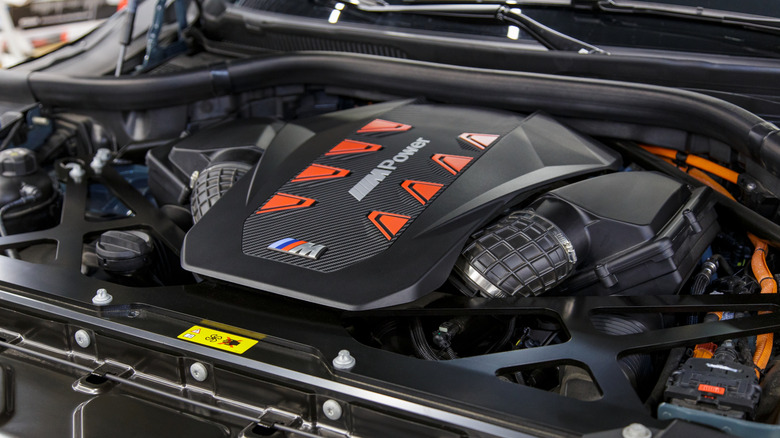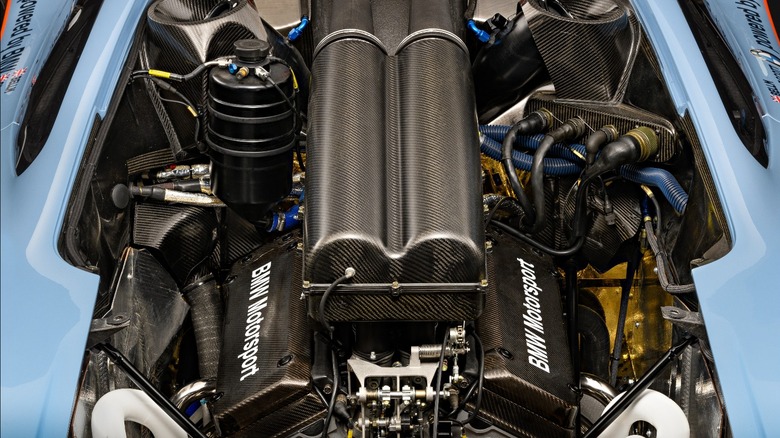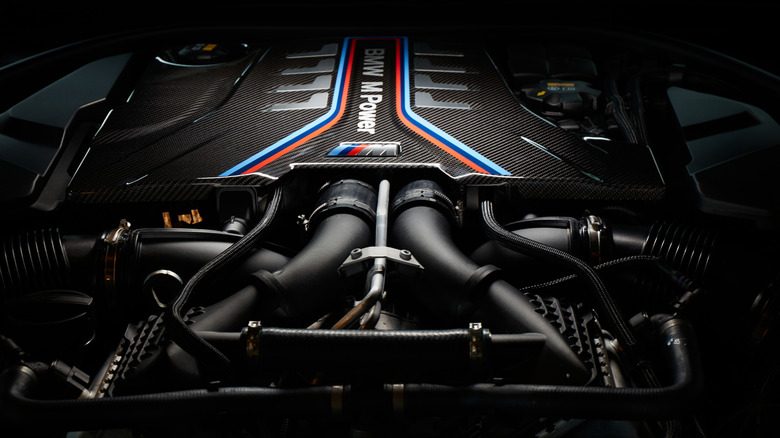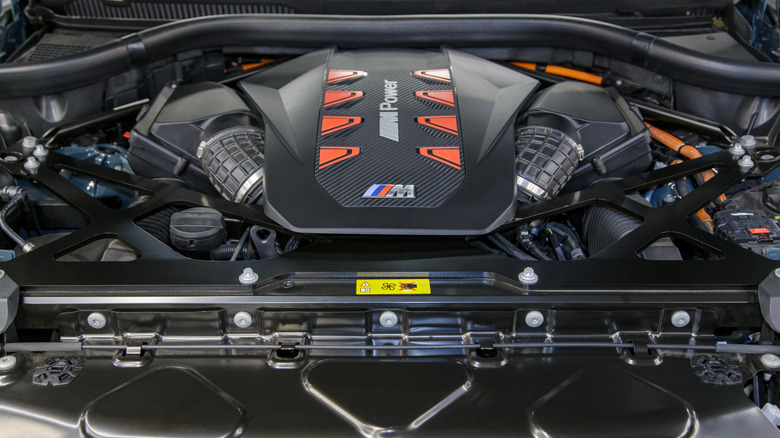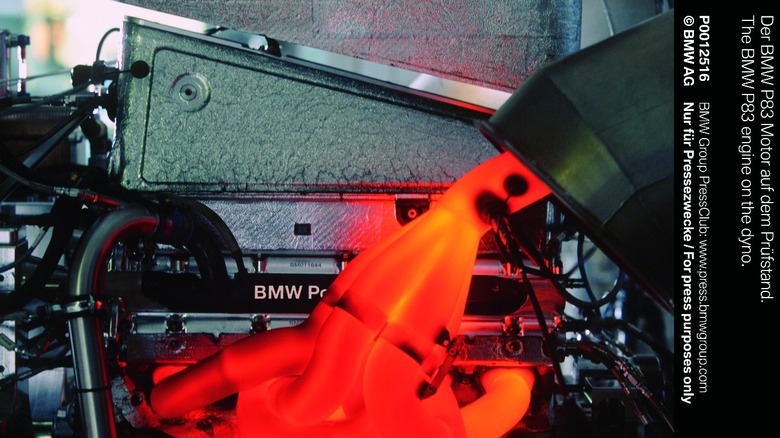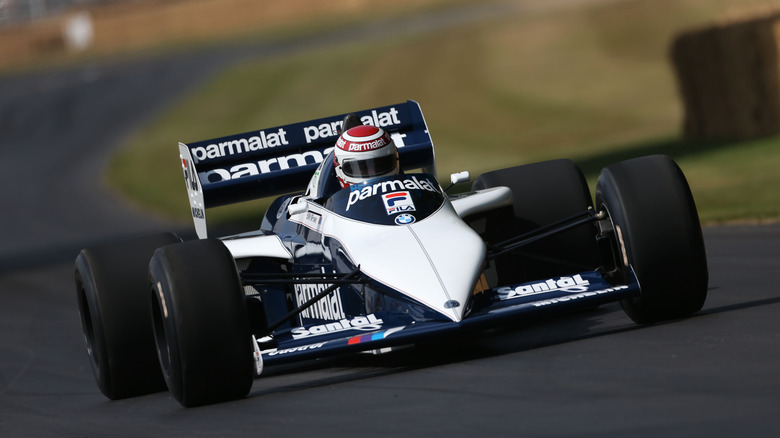5 Of The Most Powerful Engines Ever Built By BMW
If you were to assemble a group of the best automakers in the world to build the perfect car, you might have Lamborghini style it, Mercedes do the interior, and Porsche design the chassis. A strong argument can be made that BMW would be the perfect choice to tackle the engine. BMW has been building engines for over 100 years. In fact, the Bavarian marque has been building engines longer than it has been building cars. Over that century of fiddling and refining, it has built powertrains for economy-focused hatchbacks, championship-winning Formula 1 cars, and everything in between. BMW has not only built some reliable engines but also some extremely potent ones.
The company's most powerful engines cover a wide breadth of applications and designs. BMW's Motorsport division plays a large part in pumping out visceral powerhouses for BMW production models, including the 635-horsepower S63 and 738-horsepower S68 V8s. Its Formula One ventures have also produced some of the best engines to come out of the sport, like the 940-horsepower P83 V10 and 1,400-horsepower — yes, you read that right — M12/13 inline-four cylinder. One of BMW's most powerful engines, the 618-horsepower S70/2 V12, wasn't even used in a BMW but in the 1992 McLaren F1 – a car that remains the fastest naturally aspirated road car in the world to this day.
BMW S70/2 V12: 618 horsepower
In 1992, BMW created an engine so potent that the company wouldn't create a more powerful production engine until 30 years after its release. Ironically, the engine wasn't even built for a BMW. Instead, it was BMW's contribution to arguably the greatest performance road car ever built, the McLaren F1. While a product of the McLaren Formula 1 team as a collective, one man played the biggest role in ensuring that the F1 was a resounding success in every measurable way: famed Formula 1 designer, Gordon Murray.
Gordon's list of requirements for the McLaren F1 filled a comparable number of pages to a Merriam-Webster dictionary. Employing the same detail-obsessed methodology that he used for his Grand Prix cars, Gordon's vision for the F1 was uncompromising when it came to lightness, rigidity, and driver enjoyment. One of the key aspects tying the entire car together was the engine, which Gordon had an exhaustive list of demands for as well. The engine had to be naturally aspirated, produce 100 horsepower per liter, have 12 cylinders, spew out a minimum of 550 horsepower, be structurally supportive, and — most importantly — weigh under 250 kilograms (551 pounds). After Honda rejected the proposal, Gordon approached Paul Rosche, BMW M's technical director, who embraced the project with open arms.
The result was the BMW S70/2 V12 — one of the finest naturally aspirated engines ever made. A combination of race-proven technologies and lightweight materials allowed the 6.1-liter V12 to meet almost every one of Gordon's commandments. It featured all-aluminum construction, double-Vanos variable valve timing, individual throttle bodies, and used a dry-sump lubrication system, producing a peak 618 horsepower at 7,400 rpm.
BMW S63 twin-turbo V8: 635 horsepower
In the late 2000s, BMW found itself without an engine substantial enough to power some of its premium land yacht models. Its 50i-spec 7-Series and X6s needed to be quick, and BMW's naturally aspirated V8 at the time maxed out at an insufficient 362 horsepower in N62B48 guise. The twin-turbocharged N63 V8 was born out of that conundrum. The new engine introduced some pretty substantial innovations to not only BMW's powertrain department but to powertrain technology as a whole. It was the first V8 engine to use a hot-vee layout — where the engine's turbochargers were mounted in the valley between the two cylinder banks — resulting in a more compact engine while also reducing turbo spool time and improving cooling.
Three years after the N63's release, BMW released a high-potency version of the engine for use in the X5 M and X6 M SUVs. The initial S63 was built on the N63's foundation and introduced a couple of improvements including new twin-scroll turbochargers and a pulse-tuned exhaust manifold that brought output up to 547 horsepower.
Year after year, the S63 was peppered with upgrades and appeared in multiple other BMW M models including the M5, M6, and M8. In the 2011 M5, the S63 received Valvetronic variable valve lift and an increased 7,200 redline. In 2015, the then-new S63B44T2 variant arrived with even more power and torque: 567 horsepower and 553 lb-ft to be exact. The most recent revision, known as the S63B44T4 is the baddest of the bunch, churning out 635 horsepower and 553 lb-ft of torque in the BMW M5 CS.
BMW S68 twin-turbo V8: 738 horsepower
The S68 is a continuation of BMW's modular engine bloodline. Unlike the N63 and S63 twin-turbo V8 engines that predate the BMW modular engine family, the S68 takes after more modern engines like the famed B58 straight-six and B48 inline-four cylinder. Despite sharing no common parts with the S63 that it is replacing, the S68 is also a twin-turbocharged, hot-vee, 4.4-liter V8. One of the biggest differentiators between the engines is the S68's use of a 48-volt mild-hybrid system installed between the engine and transmission. It is still a relatively new engine — first arriving in the 2022 X7 — but even in starting trim, its wealth of power secures it a spot on this list.
Previously, the S designation at the beginning of the engine's name would signify that the S68 is an M-specific engine — meaning that it could only be found in full Motorsport-spec vehicles. The S68 breaks that historic cycle, though, as it will be used in a number of less-involved M-Performance vehicles as well. While the X7 M60i might have an M as a signifier, it doesn't fight in the same weight class as a car like the G90 M5, which also features the S68.
In the X7 M60i, the S68 develops 523 horsepower, and in the G90 M5, it produces 727 horsepower. Output starts to become ridiculous with the S68 variant found in the BMW XM Label, with the gas burner itself producing 577 horsepower supplemented by an additional 194 horsepower electric motor for a total of 738 horsepower. All said and done, the S68 is unashamedly the most powerful production engine that BMW has ever built up to this point.
BMW P83 V10: 940 horsepower
Formula 1 enthusiasts will know that we're in the turbo-hybrid era of the sport at this point. Over time, cylinders have been lopped off in favor of battery packs and efficient turbochargers, which has its own merits as a powertrain recipe. It wasn't always like this, though. Prior to turbo-hybrid V6s, Formula 1 cars used small displacement V8s, and before that, it was the era of the fabled V10s. While a number of teams flourished under the 1995-2005 Formula 1 engine regulations, BMW stood out as the master of the V10.
Prior to the 2000s, BMW had multiple stints in the topflight of motorsport as an engine supplier. Not to spoil the upcoming entry, but BMW did masterful work supplying engines to teams like Brabham and Benetton in the 1980s. After a 12-year hiatus between 1987 and 1999, BMW returned with a vengeance during a time of fierce competition. BMW signed a six-year deal with a titan of the sport, Williams Racing, and began developing a V10 engine to satisfy the engine regulations. BMW's first two tries were formidable, with the initial E41/4 and P80 proving that BMW could build powerful engines despite reliability woes.
BMW-Williams' best year in the sport was 2003, when BMW built a new V10 engine using the expertise it had gained in the prior two years of competition. The resulting BMW P83 was the most powerful engine on the grid that year, spewing out over 900 brake horsepower at 19,200 rpm. It was packaged into an all-new car, the FW25, which featured an entirely reworked chassis. At the hands of Juan Pablo Montoya and Ralf Schumacher, the FW25 scored four wins and secured second place for BMW-Williams in the Constructors' Championship.
BMW M12/13: 1,350 horsepower
While Formula 1's V10 era was arguably the best sounding, it wasn't anywhere close to the most powerful. That honor has to go to the 1.5-liter turbocharged engines of the early 1980s. At that point in history, Formula 1's governing body, the FIA, took a laissez-faire approach to rule-making — in terms of both safety and power limits. Either 3.0-liter naturally aspirated or 1.5-liter turbocharged engines were allowed to compete, with the latter gaining massive popularity in the early 80s as turbocharger technology steadily advanced.
It all culminated with the full-time debut of BMW's M12/13 1.5-liter turbocharged four-cylinder. The engine itself was based on the piddly little M10 four-cylinder which produced as little as 80 horsepower in the 1962 BMW 1500 but, after famed BMW engine designer Paul Rosche got his hands on it, the M12/13 was initially capable of up to 1,280 horsepower in qualifying trim. The M12/13 was, by far, the most powerful engine on the grid in 1983, securing Nelson Piquet his second Formula 1 Drivers' Title behind the wheel of the Brabham BT52.
It got even more potent in the years to come. In 1986, the M12/13's output rose to an estimated 1,400 horsepower. "Estimated" is a necessary word in that sentence, as not even BMW knew how much power the M12/13 was capable of, as the company's dynamometer couldn't measure beyond 1,280 horsepower. Purportedly, it hit 1,350 horsepower during qualifying. Even though the true capabilities of the BMW M12/13 might never be fully known, one fact rings true regardless: the BMW M12/13 is not only the most powerful engine ever built by BMW, but it is also the most powerful engine ever used in Formula 1.
